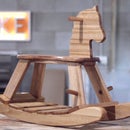Introduction: Wooden Mallet Using Dowels
The traditional way to create a wooden mallet is to use a wedge shape in the head that the shaft slides into. This is a great method but I wanted to try something a little different.
This method secures the head to the shaft using dowels instead of the wedge. The idea is that the strength of the head assembly is only important when transferring the head from one point to the point of impact. As the mallet head strikes an object all the energy is transferred to the head and the shaft is no longer "holding" the head in place.
With that concept in mind there's no need to make an elaborate wedge shape to hold the head to the shaft. In this Instructable I attach the head using dowels.
Step 1: Cut and Glue the Pieces of Wood
You'll need 2 pieces the full width of the mallet head and then another 2 pieces that, when added together with the shaft, make up the same width as the full width of the mallet head. In my case the mallet head is 140mm wide and the shaft is 40mm wide, so the 2 small pieces were 50mm each.
I glued 4 pieces together to make up the head. This was to match the shaft but your size might be different.
Step 2: Drill Holes for Dowels
If you have a drill press this will be a very simple step.
Because I don't have a drill press I made up this jig. It's a simple T with holes drilled through. Each side is marked and this is important. Side A goes against the mallet head, while side B goes against the shaft. This ensures that if you haven't drilled perfectly plumb holes (which is unfortunately quite likely) then using the guide will mean the both pieces of wood join with the dowel holes travelling in the same orientation.
Step 3: Attach Mallet Head
Now that you have drilled holes into the inner mallet head as well as the shaft, insert dowels into the inner mallet head with glue. Then attach this to the shaft with glue. Once both inner heads are attached clamp them while the glue dries.
After the glue dries you may need to flatten the inner mallet heads. I used a hand plane for this. Now you can glue the outer pieces of the mallet, making sure to glue them to the inner head as well as the shaft. This needs to be clamped for a good amount of time.
Now is a good time to put some dowels through the head to lock it all together. This step is optional, depending on your faith in wood glue.
Step 4: Finalise the Shape, Sand and Finish
Once all the glue is dry remove the clamps and cut and/or sand any excess material off. I rounded over the shaft edges using a rounder over bit in a router and cut the mallet head flush using a mitre saw.













